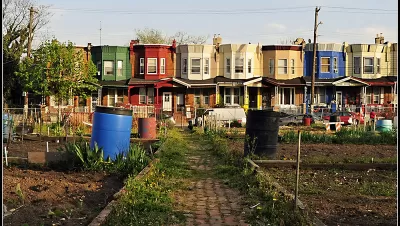Applying trauma-informed principles, reducing social isolation, and encouraging active living—how housing can be designed to promote good health.

A little more than a year ago, the COVID-19 outbreak was declared a global pandemic and government officials across the country ordered residents to shelter in their homes. While there’s been significant progress in the fight against the coronavirus with the development of advanced health treatments and the growing distribution of COVID-19 vaccines, many people are still spending most of their time indoors. However, data from the National Center for Healthy Housing shows that homes are one of the most dangerous places to be. Nearly 40 percent of residences have at least one health or safety hazard, and these issues tend to be costly to repair.
Among affordable housing advocates and health professionals, it’s commonly understood that removing health hazards like mold or lead can positively affect a residents’ health and well-being, but there are other, less familiar ways in which affordable housing can be designed to promote good health.
Shaping Healthy Affordable Housing
Dr. Lynne Dearborn, an architectural researcher and professor of architectural design at the University of Illinois at Urbana-Champaign, studies how housing and residential environments affect health. Dearborn and Dr. Sherry Ahrentzen of the University of Florida recently studied the extent that Low Income Housing Tax Credits (LIHTC)—the largest source of funding for affordable housing—helps shape healthy homes. They did this by reviewing Qualified Allocation Plans, or QAPs, which states develop annually to establish eligibility for receiving LIHTC funds.
Dearborn and Ahrentzen found that most states offer incentives to developers who site affordable housing in neighborhoods that have amenities to improve healthy living, but rarely do they require it.
Also, while most states have a least one criterion for addressing indoor air quality in their respective QAPs, few ...
FULL STORY: Housing Design That Advances Health

Alabama: Trump Terminates Settlements for Black Communities Harmed By Raw Sewage
Trump deemed the landmark civil rights agreement “illegal DEI and environmental justice policy.”

Planetizen Federal Action Tracker
A weekly monitor of how Trump’s orders and actions are impacting planners and planning in America.

The 120 Year Old Tiny Home Villages That Sheltered San Francisco’s Earthquake Refugees
More than a century ago, San Francisco mobilized to house thousands of residents displaced by the 1906 earthquake. Could their strategy offer a model for the present?

In Both Crashes and Crime, Public Transportation is Far Safer than Driving
Contrary to popular assumptions, public transportation has far lower crash and crime rates than automobile travel. For safer communities, improve and encourage transit travel.

Report: Zoning Reforms Should Complement Nashville’s Ambitious Transit Plan
Without reform, restrictive zoning codes will limit the impact of the city’s planned transit expansion and could exclude some of the residents who depend on transit the most.

Judge Orders Release of Frozen IRA, IIJA Funding
The decision is a victory for environmental groups who charged that freezing funds for critical infrastructure and disaster response programs caused “real and irreparable harm” to communities.
Urban Design for Planners 1: Software Tools
This six-course series explores essential urban design concepts using open source software and equips planners with the tools they need to participate fully in the urban design process.
Planning for Universal Design
Learn the tools for implementing Universal Design in planning regulations.
Clanton & Associates, Inc.
Jessamine County Fiscal Court
Institute for Housing and Urban Development Studies (IHS)
City of Grandview
Harvard GSD Executive Education
Toledo-Lucas County Plan Commissions
Salt Lake City
NYU Wagner Graduate School of Public Service





























